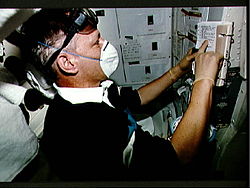- Space toilet
-
A space toilet, or zero gravity toilet, is a toilet that can be used in a weightless environment. In the absence of weight the collection and retention of liquid and solid waste is directed by use of air flow. Since the air used to direct the waste is returned to the cabin, it is filtered beforehand to control odor and cleanse bacteria. In older systems, waste water is vented into space and any solids are compressed and stored for removal upon landing. More modern systems expose solid waste to vacuum to kill bacteria, which prevents odor problems and kills pathogens.
Contents
Basic parts
There are 4 basic parts in a space toilet, the liquid waste vacuum tube, the vacuum chamber, the waste storage drawers, and the solid waste collection bags. The liquid waste vacuum tube is a 2 to 3-foot (0.91 m) long rubber or plastic hose that is attached to under the vacuum chamber. It is connected to a fan that provides suction. On the end is a detachable urine receptacle. There are 2 different kinds; for male and female astronauts. The male kind is a plastic funnel 2 to 3 inches in width and about 4 inches deep. A male astronaut would urinate directly into the funnel. He would have to keep 2 to 3 inches away to not get sucked into the funnel. The female version is a funnel that is oval in shape and is 2 inches by 4 inches wide at the rim. Near the rim of the funnel are small holes or slits for air to pass through so an astronaut can place the funnel on her body without getting sucked in. The vacuum chamber is a cylinder about 1-foot (0.30 m) deep and 6 inches wide. On the rim of it are clips where you attach waste collection bags. At the back is a fan that provides suction. The waste storage drawers are where they store the waste. Urine is pumped into one of these drawers. They freeze a sample of urine and solid waste and send it to Earth for testing. The solid waste collection bag is a detachable bag that is made of a special fabric that lets gas but not liquid or solid through. This allows the fan at the back of the vacuum chamber to pull the waste into the bag. When the astronaut is done using it he/she twists their bag and places it in a waste storage drawer.
Current designs
Space Shuttle Waste Collection System
The toilet used on the Space Shuttle is called the Waste Collection System (WCS). In addition to air flow, it also uses rotating fans to distribute solid waste for in-flight storage. Solid waste is distributed in a cylindrical container which is then exposed to vacuum to dry the waste.[1][2] Liquid waste is vented to space. During STS-46, one of the fans malfunctioned, and crew member Claude Nicollier was required to perform in-flight maintenance (IFM). An earlier, complete failure, on the eight-day STS-3 test flight, forced its two-man crew (Jack Lousma and Gordon Fullerton) to use a plastic bag for waste elimination and disposal.[citation needed]
 Diagram of the elements of the Space Shuttle WCS[3]
Diagram of the elements of the Space Shuttle WCS[3]
International Space Station
There are two toilets on the International Space Station, located in the Zvezda and Tranquility modules.[4] They use a fan-driven suction system similar to the Space Shuttle WCS. Liquid waste is collected in 20 litre containers. Solid waste is collected in individual micro-perforated bags which are stored in an aluminum container.[5] Full containers are transferred to Progress for disposal. An additional Waste and Hygiene Compartment is part of the Tranquility module launched in 2010. In 2007, NASA purchased a Russian-made toilet similar to the one already aboard ISS rather than develop one internally.[6]
On May 21, 2008, the gas liquid separator pump failed on the 7-year-old toilet in Zvezda, although the solid waste portion is still functioning. The crew attempted to replace various parts, but was unable to repair the malfunctioning part. In the interim, they used a manual mode for urine collection.[7] The crew has other options: use the toilet on the Soyuz transport module (which only has capacity for a few days of use) or to use urine collection bags as needed.[8] A replacement pump was sent from Russia in a diplomatic pouch so that Space Shuttle Discovery could take it to the station as part of mission STS-124 on June 2.[9][10][11]
Other spacecraft
The Soviet/Russian Space Station Mir's toilet also used a system similar to the WCS.[12]
While the Soyuz spacecraft had an onboard toilet facility since its introduction in 1967 (due to the additional space in the Orbital Module), all Gemini and Apollo spacecraft required astronauts to urinate in a so-called "relief tube," in which the contents were dumped into space (an example would be the urine dump scene in the movie Apollo 13), while fecal matter were collected in specially-designed bags. The Skylab space station, used by NASA between May, 1973 and March, 1974, had an onboard WCS facility which served as a prototype for the Shuttle's WCS, but also featured an onboard shower facility. The Skylab toilet, which was designed and built by the Fairchild Republic Corp. on Long Island, was primarily a medical system to collect and return to earth samples of urine, feces and vomit so that calcium balance in astronauts could be studied.
Even with the facilities, astronauts and cosmonauts for both launch systems employ pre-launch bowel clearing and low-residue diets to minimize the need for defecation.[13] The Soyuz toilet has been used on a return mission from Mir.[12]
NPP Zvezda is a Russian developer of space equipment, which includes zero gravity toilets.[14] The unit that failed in 2008 aboard the ISS was of this type.
See also
References
- ^ Mellette, Robert (1987-06-03). "Space Shuttle Science". Curriculum Unit 87.06.03. http://www.yale.edu/ynhti/curriculum/units/1987/6/87.06.03.x.html. Retrieved 2006-12-21.
- ^ NASA (2002-04-07). "HSF - The Shuttle - Waste Collection System". http://spaceflight.nasa.gov/shuttle/reference/shutref/orbiter/eclss/wcs.html. Retrieved 2006-12-21.
- ^ NASA (2001-11-15). "Configuration Changes and Certification Status - Shuttle Urine Pre-treat Assembly". STS-108 Flight Readiness Review. http://www.jsc.nasa.gov/news/columbia/frr/sts-108/12_vehicle.pdf. Retrieved 2006-12-28.
- ^ Cheryl L. Mansfield (7 November 2008). "Station Prepares for Expanding Crew". NASA. http://www.nasa.gov/mission_pages/station/behindscenes/126_payload.html. Retrieved 17 September 2009.
- ^ Lu, Ed (2003-09-08). "HSF - International Space Station - "Greetings Earthling"". http://spaceflight.nasa.gov/station/crew/exp7/luletters/lu_letter9.html. Retrieved 2006-12-21.
- ^ Fareastgizmos.com (2007-07-06). ""19 million US Dollars for a space station toilet"". http://www.fareastgizmos.com/other_stuff/19_million_us_dollars_for_a_space_station_toilet.php. Retrieved 2007-07-09.
- ^ "Toilet trouble for space station". BBC News. 2008-05-29. http://news.bbc.co.uk/1/hi/world/americas/7425180.stm. Retrieved 2010-01-04.
- ^ "Space station struggles with balky toilet". http://www.msnbc.msn.com/id/24841375/.
- ^ "Astronauts To Fix Space Station Toilet". http://www.local6.com/technology/16402637/detail.html.
- ^ "ISS - Zvezda Bathroom Repairs and Shuttle Preps for Crew". http://spacefellowship.com/News/?p=5448.
- ^ "Space Station Toilet Parts Set for Liftoff". http://www.redorbit.com/news/space/1407194/space_station_toilet_parts_set_for_liftoff.
- ^ a b Shuttleworth, Mark (2002-02-09). "Toilet Training". First African in Space. http://www.firstafricaninspace.com/home/mission/logs/1/20020209.shtml. Retrieved 2006-12-28.
- ^ http://www.buzzle.com/articles/low-residue-diet.html
- ^ http://www.zvezda-npp.ru/engl/asy.html Assenisation Sanity Unit ASU-8A
External links
- NASA Video shows how to train for and use the Space Shuttle toilet
- http://esamultimedia.esa.int/docs/issedukit/en/html/t030405r1.html
- http://www.esa.int/esaHS/SEMHOB9ATME_business_2.html
- http://liftoff.msfc.nasa.gov/news/2001/News-StationPlumbing.asp
- http://edspace.nasa.gov/livespace/gottago.html
- http://www.abc.net.au/science/k2/moments/s348188.htm
- http://www.historychannel.com/exhibits/hometech/spacetoilet.html
- http://space.about.com/cs/spaceshuttles/a/bathroominspace.htm
- http://www.newscientist.com/article.ns?id=dn1093
- http://www.boingboing.net/2005/07/13/nasas_squeamish_spac.html
- http://www.hightechscience.org/zero_gravity_toilet.htm
- http://news.uns.purdue.edu/UNS/html4ever/2004/040825.Volenec.mars.html
- http://www.planet4589.org/jcm/trips/06/moscow/mir.html
- http://news.bbc.co.uk/2/hi/uk_news/magazine/6640035.stm
- NASA buys $19 million Russian toilet system for international space station
- Canadian Astronaut Chris Hadfield describes ISS space toilet usage
- "Getting a Handle on Space Toilets", Scientific American, May 30, 2008
- "Astronauts Swab the Deck"
Spaceflight General 
Applications Earth observation satellites (Spy satellites · Weather satellites) · Private spaceflight · Satellite navigation · Space archaeology · Space architecture · Space colonization · Space exploration · Space medicine · Space tourismHuman spaceflight GeneralHazardsMajor projectsApollo · Constellation · Gemini · International Space Station · Mercury · Mir · Shenzhou · Soyuz · Space Shuttle · Voskhod · VostokSpacecraft Destinations Space launch Space agencies Toilets Features Types See also Female urination device · Privatization of public toilets · Washroom attendant · Toilet paper orientation · History of sanitationCategories:- Toilets
- Human spaceflight
Wikimedia Foundation. 2010.

